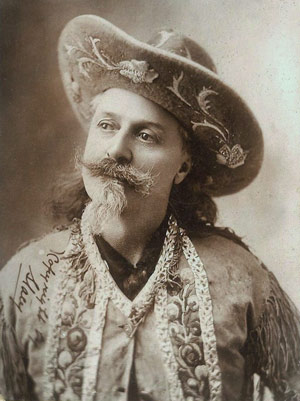Annie Oakley
 Saturday, March 11, 2017 at 9:09AM
Saturday, March 11, 2017 at 9:09AM  A wistful Buffalo Bill Cody, circa 1890, a couple of years after he had gone to England to visit Queen Victoria.
A wistful Buffalo Bill Cody, circa 1890, a couple of years after he had gone to England to visit Queen Victoria.
This has been a week or so, here, of the physical and cultural landscapes of the American southwest, long before malls and freeways, snowbirds, wetbacks and ICE. The West was a powerful image, for those of us in the west who didn't entirely see it as those in the East might have – fenceless, lawless, full of saguaro cactus and mesas. Rather those of us in the west north saw it as something our grandparents and parents did. They knew the flowers, the grasses, the winters, the colourful characters. Allegedly my great-grandmother had an affair with Robert Service; one grandfather, an executive with Imperial Tobacco in Edmonton, had joined a travelling circus at 13, the other grandfather lived briefly near Olds in a chicken coop, with his school tie, violin and dancing pumps as an apprentice gentleman farmer: these were real, not myth.
At the same time we were awash with the mythology of the American West as it came through popular culture and that increased to a tsunami after WWII. For example, there was a tv program for kids about Annie Oakley who had worked for Buffalo Bill, Civil War veteran, Indian hunter, showman, huckster. In Grade One I got an Annie Oakley lunch kit. My brother three years later got a Roy Rogers lunch kit which he promptly lost, for which I don't blame him, it had Dale Evans on it, who was such a drip.
Annie Oakley, sharpshooter, a little proto-feminist. In the tv program her sidekick was Tagg, a kid, a boy; her horse was beautiful. We all drew horses as little girls, before we moved onto ballerinas, leaving the wild west behind. However, Annie Oakley was a far more exotic model for very little girls than, say, Anne of Green Gables, a book which I could not read at all. For Annie Oakley there were no rules; for Anne Shirley it was all about fighting the rules that cramped her style. It made no sense to me.
The west is different from the east; it is another country.
 Aladdin Industries Annie Oakley lunch kit, 1955. This one was on Ebay and sold for $350. The cream edges were pressed like leather, and the sides had a belt of bullets running around them.
Aladdin Industries Annie Oakley lunch kit, 1955. This one was on Ebay and sold for $350. The cream edges were pressed like leather, and the sides had a belt of bullets running around them.
 culture,
culture,  geography,
geography,  material culture
material culture 

Reader Comments